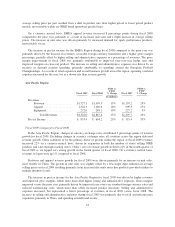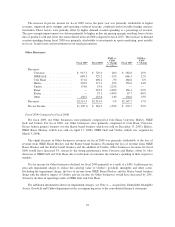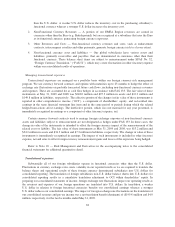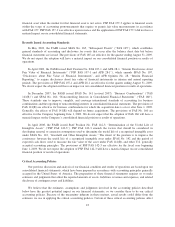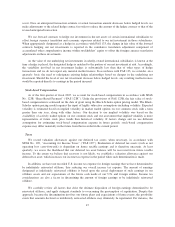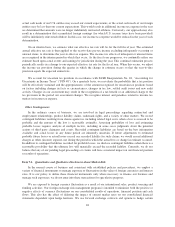Nike 2009 Annual Report Download - page 44
Download and view the complete annual report
Please find page 44 of the 2009 Nike annual report below. You can navigate through the pages in the report by either clicking on the pages listed below, or by using the keyword search tool below to find specific information within the annual report.event we were to have any borrowings outstanding under this facility, failed to meet any covenant, and were
unable to obtain a waiver from a majority of the banks, any borrowings would become immediately due and
payable. As of May 31, 2009, we were in full compliance with each of these covenants and believe it is unlikely
we will fail to meet any of these covenants in the foreseeable future.
Liquidity is also provided by our $1 billion commercial paper program. As of May 31, 2009, $100 million
was outstanding under this program at a weighted average interest rate of 0.40%. This borrowing was repaid
subsequent to May 31, 2009. We may issue commercial paper from time to time during fiscal 2010 depending on
general corporate needs. We currently have short-term debt ratings of A1 and P1 from Standard and Poor’s
Corporation and Moody’s Investor Services, respectively.
Despite recent uncertainties in the financial markets, to date we have not experienced difficulty accessing
the credit markets or incurred higher interest costs. Continuing volatility in the capital markets, however, may
increase costs associated with issuing commercial paper or other debt instruments or affect our ability to access
those markets. Notwithstanding these adverse market conditions, we believe that current cash and short-term
investment balances and cash generated by operations, together with access to external sources of funds as
described above, will be sufficient to meet our operating and capital needs in the foreseeable future.
Recently Adopted Accounting Standards
On December 1, 2008, we adopted SFAS No. 161, “Disclosures about Derivative Instruments and Hedging
Activities — an amendment of FASB Statement No. 133” (“FAS 161”), which provides revised guidance for
enhanced disclosures about how and why an entity uses derivative instruments, how derivative instruments and
the related hedged items are accounted for under FAS 133, and how derivative instruments and the related
hedged items affect an entity’s financial position, financial performance and cash flows. The adoption of FAS
161 did not have an impact on our consolidated financial position or results of operations. For additional
information, see Note 18 — Risk Management and Derivatives in the accompanying notes to the consolidated
financial statements.
On June 1, 2008, we adopted SFAS No. 157, “Fair Value Measurements” (“FAS 157”) for financial assets
and liabilities, which clarifies the meaning of fair value, establishes a framework for measuring fair value and
expands disclosures about fair value measurements. Fair value is defined under FAS 157 as the exchange price
that would be received for an asset or paid to transfer a liability in the principal or most advantageous market for
the assets or liability in an orderly transaction between market participants on the measurement date. Subsequent
changes in fair value of these financial assets and liabilities are recognized in earnings or other comprehensive
income when they occur. The effective date of the provisions of FAS 157 for non-financial assets and liabilities,
except for items recognized at fair value on a recurring basis, was deferred by FASB Staff Position FAS 157-2
(“FSP FAS 157-2”) and is effective for the fiscal year beginning June 1, 2009. The adoption of FAS 157 for
financial assets and liabilities did not have an impact on our consolidated financial position or results of
operations. The adoption of FAS 157 for non-financial assets and liabilities is not expected to have a significant
impact on our consolidated financial position or results of operations. See Note 6 — Fair Value Measurements in
the accompanying notes to the consolidated financial statements for further discussion.
Also effective June 1, 2008, we adopted SFAS No. 159, “The Fair Value Option for Financial Assets and
Financial Liabilities” (“FAS 159”), which allows an entity the irrevocable option to elect fair value for the initial
and subsequent measurement for certain financial assets and liabilities on a contract-by-contract basis. As of
May 31, 2009, we have not elected the fair value option for any additional financial assets and liabilities beyond
those already prescribed by accounting principles generally accepted in the United States.
In October 2008, the FASB issued Staff Position No. FAS 157-3, “Determining the Fair Value of a
Financial Asset in a Market That Is Not Active” (“FSP FAS 157-3”). FSP FAS 157-3 clarifies the application of
FAS 157 in a market that is not active and defines additional key criteria in determining the fair value of a
42



